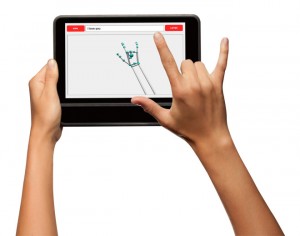MotionSavvy is putting forward a device to help the hearing impaired listen and speak. UNI, a sensitive tablet that interprets sign language and turns it into text and audible voice.
There are plenty of things to take for granted in this life, and the ability to hear is one of them.
MotionSavvy, is building a tablet case that leverages the power of the Leap Motion controller in order to translate American Sign Language into English and vice versa. The entire 6-person team is deaf.
Known as UNI, the case uses gesture recognition technology developed by Leap Motion to translate sign language into audible speech. It then merges this with voice recognition technology to convert spoken word to text.
Through Leap Motion sensors, the device reads the movement of the hands and decodes it to be heard or read.
This innovative device hopes to give the deaf people the ability to live the lifestyle they want and have power over their lives. If they are able to communicate then it would help them greatly in their education or for jobs. This tablet can serve as a virtual interpreter for the deaf.
One of the challenges that Motion Savvy had to overcome was that sign language is a complex form with its own colloquialisms and geographical differences, so the main difficulty was to get a digital dictionary for all.
The MotionSavvy case embeds the Leap, and the MotionSavvy software leverages the Leap’s 3D motion recognition, which detects when a person is using ASL and converts it to text or voice.
The software also has voice recognition through the tablet’s mic, which allows a hearing person to respond with voice to the person signing. It then converts their voice into text, which the hearing-impaired receiver can understand.
Right now, the prototype only understands about 100 words but the inventors hope to eventually include all the possible signs necessary to make this an effective tool. There are many thousands of signs in ASL alone, and various different “accents” or ways it is spoken. MotionSavvy eventually wants to build apps on Android, iOS and Windows Phone, and have the hardware work with any mobile phone. This will allow a deaf individual to feel as if the product is an extension of her/himself.
As there are a variety of signs for any given word, users can upload new signs using a feature called Sign Builder. The system learns how individual user’s sign, while also distributing each new sign to every UNI device. ‘This could really give deaf people the power to live the lifestyle they want to live. We think that is very powerful.’
Just last week, Transcense, launched an IndieGoGo campaign for an app that provides real-time voice recognition so deaf people can follow a conversation, but unlike the UNI, it doesn’t give deaf people who haven’t mastered speech a clear way to talk back.
For MotionSavvy, that is the most important part that they are providing in their device.‘I brought this to a table of older deaf people, and they all freaked out.’
If UNI can achieve its intended purpose facilitating one-on-one communication then it could become easier for deaf people to get decent jobs
For more information please visit: www.motionsavvy.com


Comments are closed.